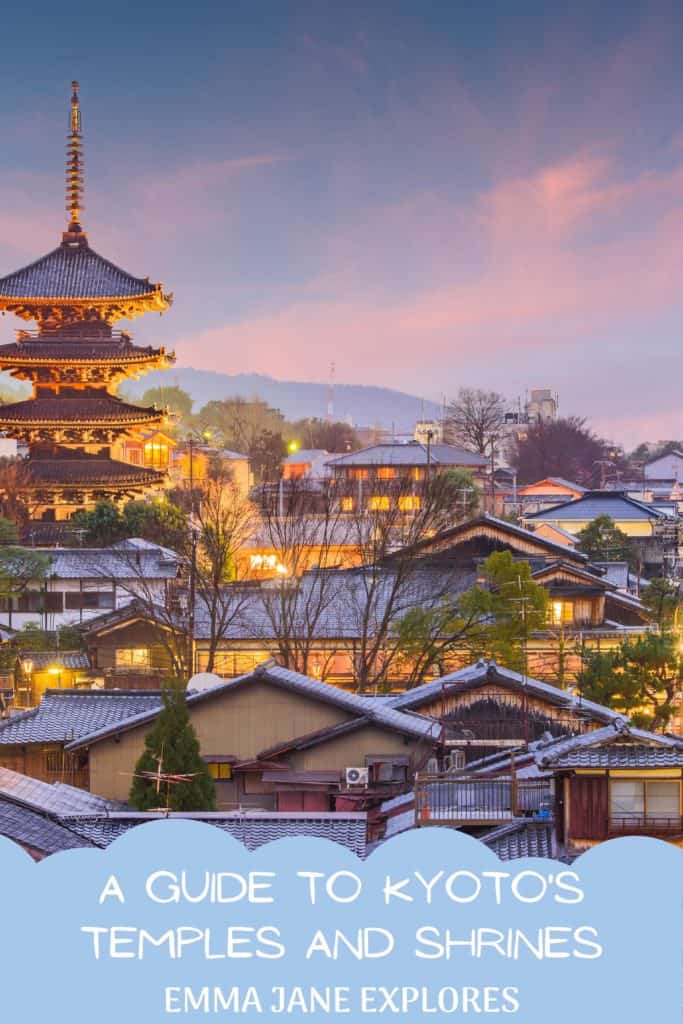The Best Temples and Shrines to Visit in Kyoto

The city of Kyoto is synonymous with Japan’s spiritual side. There are so many temples and shrines in Kyoto and the surrounding areas that it would be impossible to list them all.
Which temples and shrines in Kyoto are worth visiting?
The best temples and shrines in Kyoto are spread out amongst the forested hills that surround the city.
The former Japanese capital still has all of its old-world charm, but it is possible to get a bit overwhelmed by the sheer number of shrines and temples in the area, many of them on the UNESCO World Heritage register.
I’ve pulled together this guide to the must visit temples and shrines in Kyoto, featuring inputs from other Kyoto-loving travel bloggers, to help you decide which of the many religious sites in the area should make it onto your Kyoto itinerary.
Where to stay to visit these temples and shrines in Kyoto?
I’d always recommend staying in the Gion or Higashiyama area in Kyoto. There, you’re close to many of the shrines and temples but you’re also very close to public transport to access the ones that are further afield.
These areas come alive by lantern light in the evening and restaurants and bars operate well into the night. You might even spot an elusive Geisha in these traditional areas of Kyoto.
If you’d like to experience a traditional stay in a Ryokan (a Japanese hotel with tatami mat floor and futon for sleeping) then Ryokan Motonago is a great option in the area. For something more modern, but just as lovely, the Gion Elite Terrace is always a winner.
Booking.comThe best temples and shrines in Kyoto to visit
Tenryu-Ji
In the Arashiyama district of Kyoto, Tenryu-ji is the centrepiece of the town with it’s gorgeous scenic garden and pond made even more beautiful with the woodland hills stretching up behind it.
Walking the grounds of this stunning Zen Buddhist temple certainly invokes a feeling of peace and contentment, even in the most cynical among us.
It’s also part of the UNESCO World Heritage listing under the ‘Historic Monuments of Ancient Kyoto’. In the spring, cherry blossoms adorn the garden and in my favourite season, Autumn, the fire-red Japanese maple leaves provide some incredible colour to the peaceful garden.
To get to the Arashiyama area from downtown Kyoto, I recommend getting the Randen electric tram. You can grab a day pass and spend a day exploring the area as well as heading over to see the famed Kinkaku-ji in the afternoon. Entry into Tenryu-ji is 800 JPY for entry into the temple and gardens.
Contributed by me, Emma Jane Explores
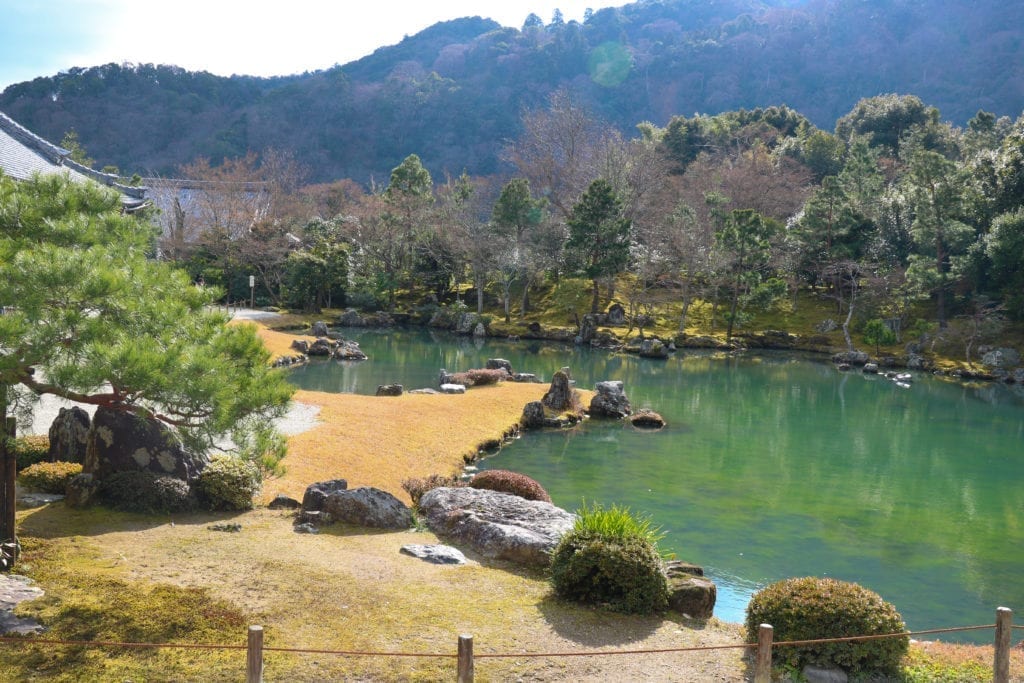
Fushimi Inari Taisha
Fushimi Inari Shrine was definitely my favourite Shrine in Kyoto and a great place in Kyoto to visit with kids. This Shinto Shrine sits at the base of a Mount Inari and seems to have an endless number of Torii Gates leading you up the 233m high mountain.
Many people won’t make it to the top; I made it within a couple of hundred metres, but ran out of time as we had a tight schedule. There is an amazing look out point about three quarters of the way up and gives you an amazing view over Kyoto.
Inari is the Shinto God of rice. There are a number of statues of foxes along the trail up Mount Inari; foxes are believed to be the messenger of Inari.
This Shrine gets very busy with tourists and it popular with Japanese tourists as well. I suggest you get there early; we arrived at 8.30am and commenced the climb and got some wonderful photos without other people in them.
Contributed by Our Three Kids vs The World
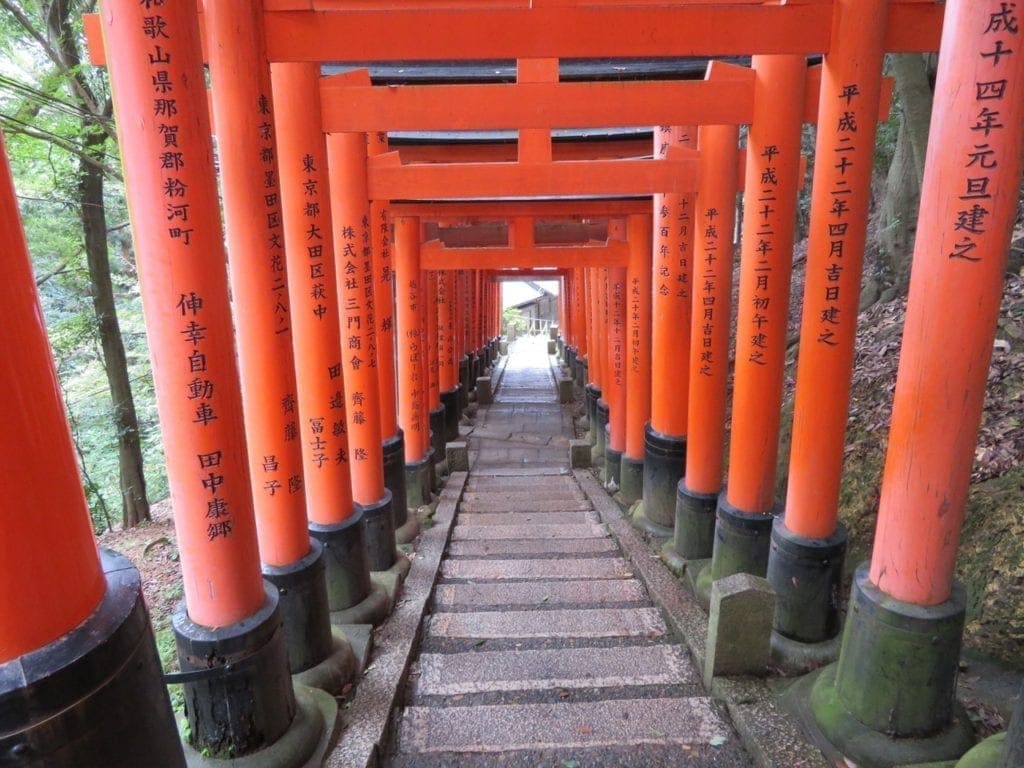
Saihoji Moss Temple
A visit to Saihoji moss temple (also called Kokedera) starts with a ritual activity in the temple. This might be Buddhist chanting or might involve copying the heart sutra in ink. I loved practicing Japanese calligraphy by copying the Japanese kanji characters. The visit then continues into the garden, where about 200 varieties of moss form a golden carpet around a heart-shaped lake.
Stroll slowly through the winding paths under trees that throw mottled light onto the lake and the tiny islands that help make the shape of the Japanese kanji character for ‘heart’. Traditional teahouses poke out from the trees, helping create a magical landscape. A second ‘dry’ garden forms the more traditional Japanese garden of raked sand and rocks. This is a quiet, meditative experience.
Visiting Saiho-ji requires an appointment – send a return-addressed postcard to the temple at least a month before you plan to visit. If you don’t live in Japan, the easiest way to do this is to ask your hotel to arrange this for you.
Contributed by James Ian from Travel Collecting
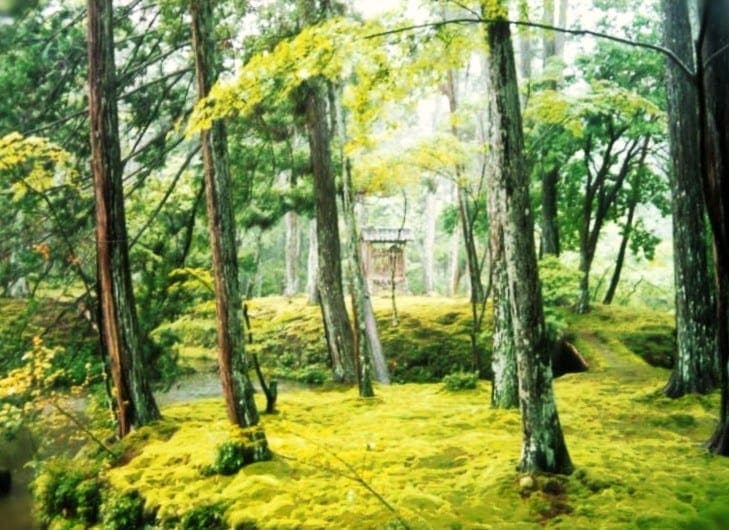
Kinkaku-Ji
Kinkaku-ji is one of most popular attractions in Kyoto, and for good reason. Also known as the ‘Golden Pavilion’, Kinkaku-ji is a Zen Buddhist temple covered in gold leaf which serenely reflects across a pond. You can’t go inside the temple, but you can walk around the pond for different perspectives of the temple and through the ground’s lovely Zen garden.
I couldn’t quite decide whether Kinkaku-ji was a peaceful site for inward reflection, or an entirely extravagent use of resources. Regardless of your view, the Golden Pavillion certainly has an interesting history. The original building dates back to the 14th century, and was burned down in 1950 by a troubled novice monk who then attempted to commit suicide. The current temple was rebuilt in 1955.
Kinkaku-ji attracts hordes of tourists. Try to avoid the crowds by visiting shortly after opening or before closing on a weekday (open daily 9am-5pm, Y400 entry). Kinkaku-Ji is in north west Kyoto, roughly 8km from the city. It’s outside the main temple area of Higashiyama and is most easily reached by bus, as part of a tour or on a bike if you’re more active.
Contributed by Claire from The Adventurous Flashpacker
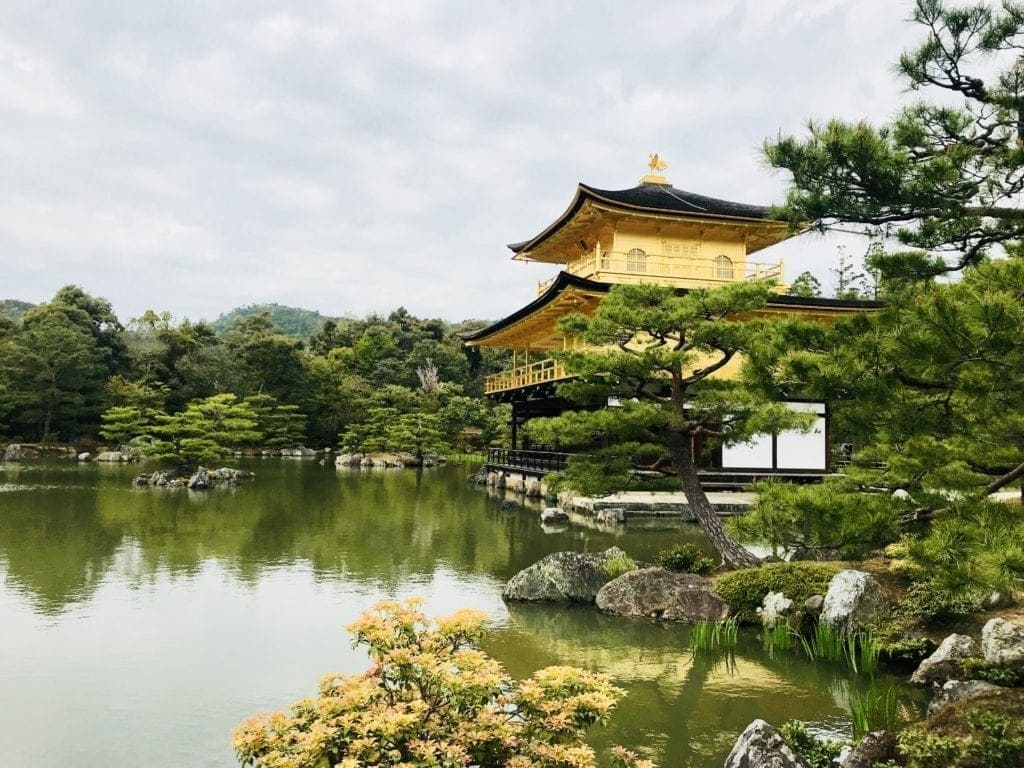
Chion-In
Chion-in is the head temple of the Jodo sect of Japanese Buddhism in Kyoto’s Higashiyama District, north of Maruyama Park. Temple grounds are always open and entrance is free. This is a great temple to spend a few hours exploring. On a February morning, we had quite a few areas of the grounds to ourselves or only had to share it with a few other people.
However, this is still one of the most popular temples in Kyoto, for good reason. You’re greeted by the San-mon gate, the widest wooden gate in Japan, at the top of 50 steps. The main building is still home to quite a few religious ceremonies. While it may not be as colorful in February, a visit during the summer months will have the grounds full of lush green vegetation adding to the beauty of the temple and grounds. No matter when you visit Kyoto, this is a must see temple.
Contributed by Megan from Red Around The World

Kiyomizu-Dera
Kiyomizu-dera is one of Kyoto’s biggest and best temples. It’s a UNESCO World Heritage Site and you absolutely must visit it if you’re in Kyoto. Getting to Kiyomizu-dera is part of the fun. Walk through the streets of Gion, one of Kyoto’s most historic and interesting areas. The streets are packed with shops and street food stalls, and of course, tourists.
Once you arrive there is more to do here than at the typical temple. You’ll find pagodas and separate temple buildings, all very pretty and interesting to look around. There is also a small Shinto shrine here, dedicated to the god of love. You’re supposed to close your eyes and try to find your way between two special stones, placed almost 20 metres apart. If you can do this then you’ll find your perfect match!
The main building at Kiyomizu-dera is made entirely of wood, without using any nails. There’s a large balcony giving great views out over Kyoto, and cherry blossoms and maple trees in the right season. You should be aware that the main hall is covered for renovation until 2020. However, this won’t stop you visiting and you’re still able to go out on the main balcony.
Contributed by Emily from Kids and Compass
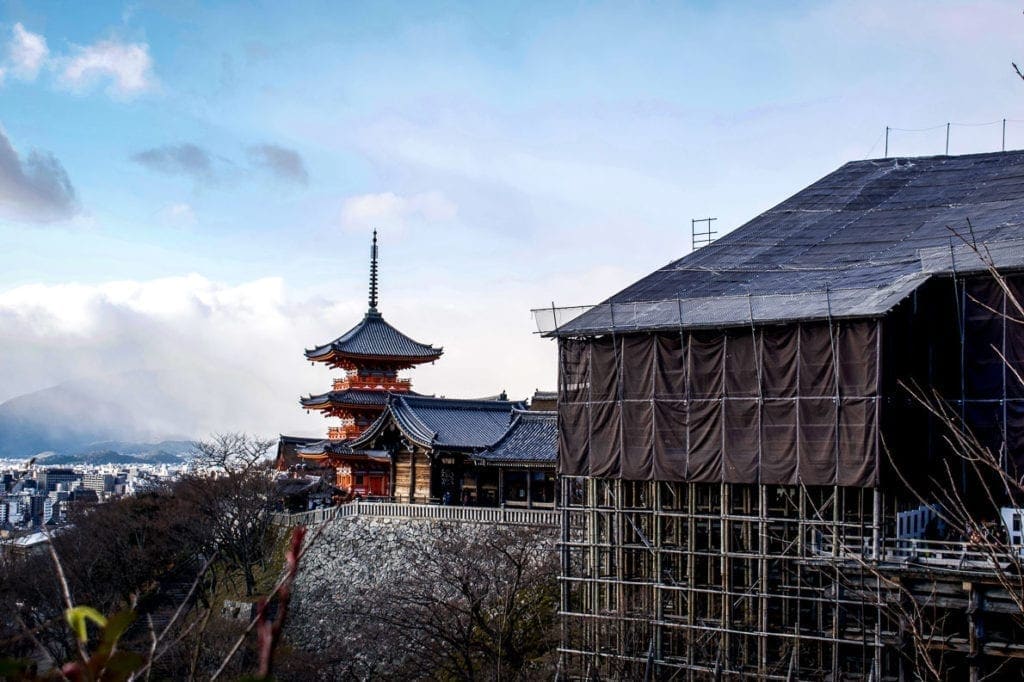
Otagi Nenbutsu
If you love quirky and cute, you will love visiting this little-known temple on the outskirts of Kyoto. At first, when you enter there is nothing out of the ordinary.
Otagi Nenbutsu is green, peaceful, and well-groomed just like any other temple, but this one is special. walk a little up the path and you will begin to notice small stone statues. These statues are called “rakan,” and it is said that you can find yourself in the visage of a rakan.
Each rakan has its own face and personality. It might be holding a cell phone or a cat. You truly can find yourself there, and oh how fun it is. If you or anyone in your group is tired of temple tromping, you will definitely still want to see this one. It’s everyone’s favourite!
Contributed by Corinne from Reflections Enroute
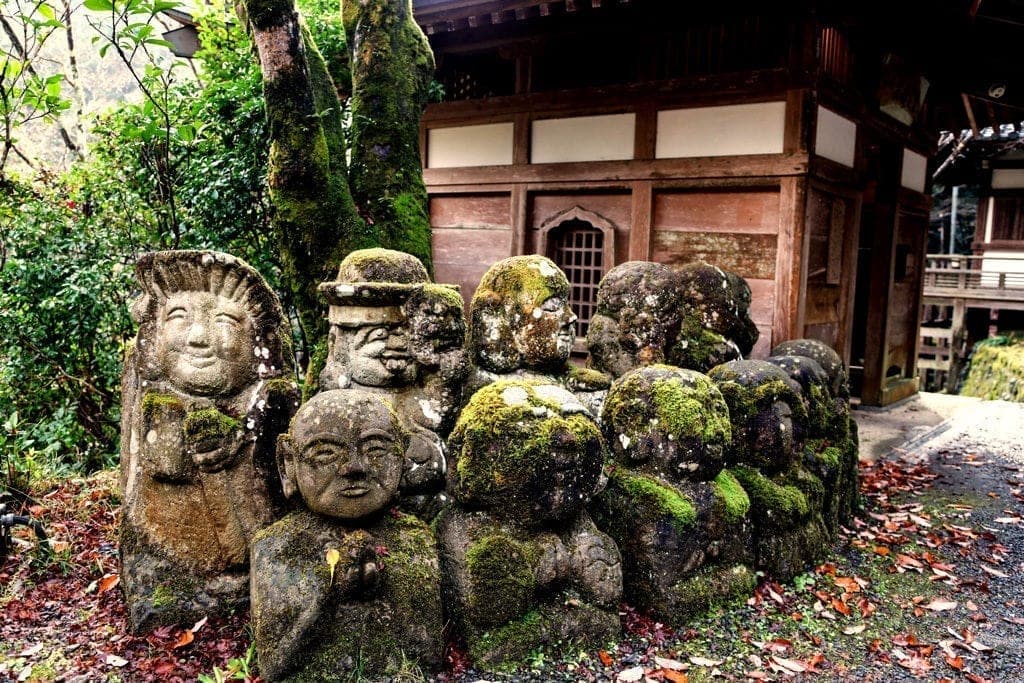
Kodai-ji
Kodai-ji Temple was founded in 1605, and it is one of the most beautiful temples in the Southern Higashiyama area of Kyoto. Kodai-ji is not very touristy, yet the temple has such a peaceful garden with a little bamboo grove which is reminiscent of Arashiyama. Also, there is a little museum, which has paintings of Buddha Nirvana (Nehan-zu) at Rishodo hall. The walls in the hall are covered in paintings of Buddha Nirvana, and the atmosphere is peaceful.
Normally, last entry to the temple is 5:00 pm. However, during special periods the temple and its environment is illuminated during the night, and the temple reopens from sunset to 9:30 pm.
In spring, the cherry blossoms are illuminated as well, while in the autumn the trees around the pond of the temple are illuminated. I highly recommend you experience the entrancing night view. Kodai-ji Temple is located right next to Ninenzaka Street. The area is nice to just stroll around and have a feel of the place. There are also plenty of restaurants and tea houses to refresh yourself at as you explore.
Contributed by Yuki from Finding Yoki

Ginkaku-Ji
The Silver Pavilion of Ginkaku-Ji can be found at the end of the Philosopher’s Path in the Sakyo ward of Kyoto. This Zen Buddhist temple is actually not silver at all, but is said to appear silvery in the moonlight.
Modelled after the famous Golden Pavilion of Kinkaku-Ji, this lovely temple features some stunning gardens including a moss garden and a dry sand garden. This is one of Kyoto’s temples that does charge an entrance fee of 500 JPY for adults and 300 JPY for children, but it is lovely enough to warrant the charge.
Ginkaku-Ji is one of the many sites in Kyoto that has been designated on the UNESCO World Heritage list and dates back to 1482 when the Shogun of the time built his retirement complex – later converted to a Buddhist temple.
Contributed by me, Emma Jane Explores

Yasaka Shrine
Yasaka Shrine is a huge Shinto shrine between the Gion and Higashiyama districts of Kyoto. Free to enter and wander around, this large complex is often bustling, particularly around the time of New Year’s Day and the Gion Matsuri festival in July. It is a great spot to view Japanese visitors in traditional dress coming to worship.
I enjoyed visiting Yasaka Shrine particularly for the lanterns that are lit in the evening, so be sure to incorporate a dusk visit to see this beautiful sight. There are also plenty of ema – the wooden boards you see hanging at temples and shrines – that locals and tourists alike have written on expressing their hopes and dreams for the future. Yasaka Shrine has one of the best displays of these.
The complex has many subshrines and is great to walk around. One notable sub shrine is the ‘Beauty Shrine’ where you can pray specifically for lovely skin or a beautiful heart by dripping a couple of drops of the shrine’s water on yourself.
Contributed by me, Emma Jane Explores
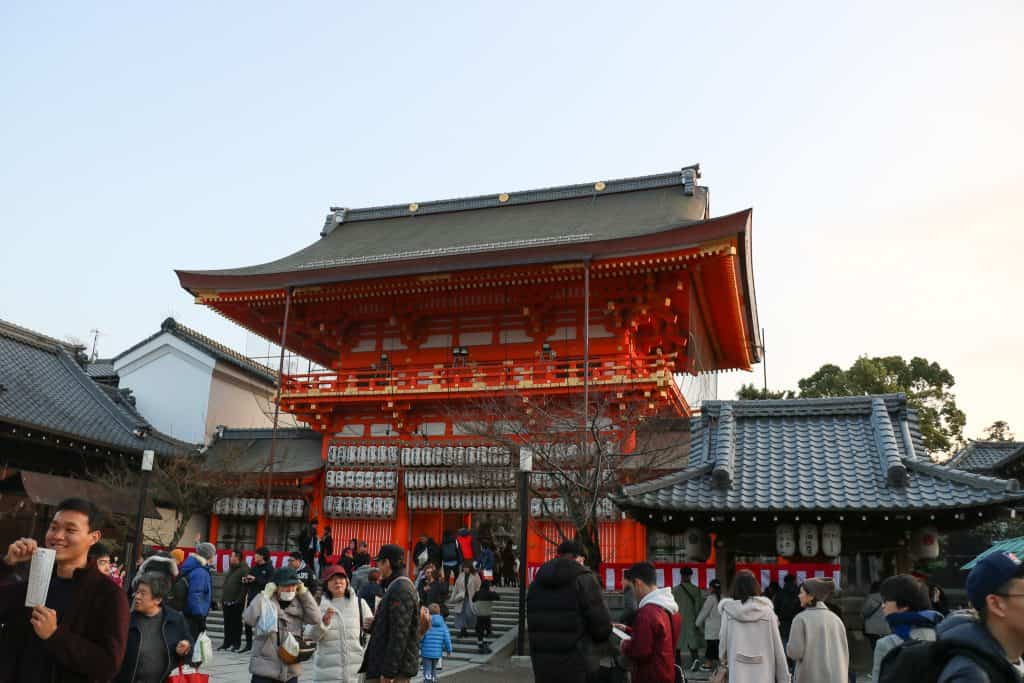
Ryoan-Ji
Ryoan-Ji is another temple located in the Arashiyama region of Kyoto and is yet another site that has made it onto the UNESCO World Heritage list.
Ryoan-Ji is famous for its raked stone garden where quiet contemplative thought is the order of the day. It is said that from any angle, there is always one of the large stones in the raked garden that is not visible.
This temple is part of the Rinzai Zen Buddhist sect and whilst the raked garden is definitely the most unique part of the complex, there are also beautiful gardens with a lovely pond to explore. Entry costs 500 JPY per visitor. Ryoan-Ji is best visited on a day trip out to Arashiyama where you can spend a day exploring Tenryu-Ji, Arashiyama Bamboo Forest and Kinkaku-Ji as well.
Contributed by me, Emma Jane Explores

Temples and Shrines in Kyoto FAQs
What is the best time to visit Kyoto?
Kyoto is beautiful at any time of year, but the two hero seasons are definitely Spring and Autumn. Spring is famous for the cherry blossoms that really bring the iconic Kyoto imagery to life. However, my favourite season is Autumn foliage time when the Japanese maple leaves turn red and make the temples and shrines of the city absolutely stunning.
What should I wear to visit temples and shrines in Kyoto?
Like any spiritual site around the world, respectful dressing is always appreciated. Usually this means covered shoulders and clothing that covers your upper legs (usually below the knee is considered OK). You’ll see plenty of Japanese in traditional dress at the temples and shrines. Also, wear shoes that are easy to slip on and off as you’ll need to remove them to enter the inside of temple buildings.
Are Kyoto temples and shrines free to visit?
This very much depends on the individual temple or shrine. Many of the more famous ones such as Kinkaku-Ji, Tenryu-Ji, Ryoan-Ji and Ginkaku-Ji will charge an entry fee. Fushimi Inari Taisha and Yasaka Shrine, however, have no entrance fee.
How many temples and shrines are in Kyoto?
There are over 1600 Buddhist temples and over 400 Shinto shrines in Kyoto, so it would be impossible to visit them all.
What is the difference between a temple and a shrine?
Shrines are for the Shinto religion which is the original Japanese religion. You’ll see torii gates marking entrance-ways to the Shinto Shrines. By contrast, temples in Japan are Buddhist. Buddhism and Shintoism have co-existed in Japan for a long time, but Shintoism is uniquely Japanese.
How long should I spend in Kyoto?
It is possible to spend a huge amount of time exploring the magic of Kyoto, however you can get a great sampler of the city in three days. I’d recommend spending one day in the Gion/Higashiyama area, one day in Arashiyama and then a day exploring the Nishiki Market, Nijo Castle and Imperial Palace with each night spent in either Gion or Pontocho Alley.
Like this post on the best temples and shrines to visit in Kyoto?
Pin to save it for later!
